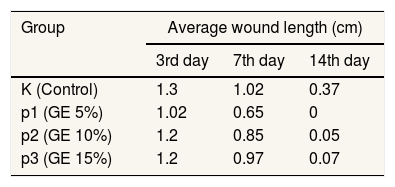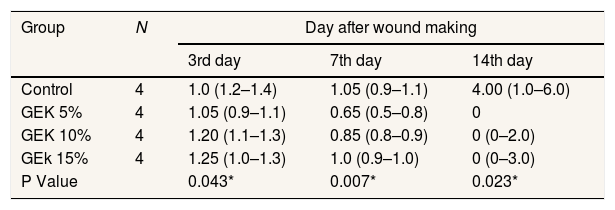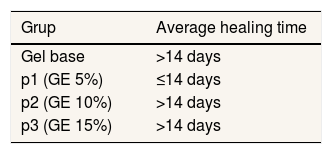
The 3rd International Nursing and Health Sciences Students and Health Care Professionals Conference (INHSP)
Más datosThis research was basic research to identify the effect of turmeric extract tested by the in vivo method. The purpose of this study was to identify differences in the length of the wound at each concentration of gel preparations on days 3, 7, and 14, as well as differences in wound healing time at each concentration of gel preparations and, identify the most effective gel preparations for wound healing.
MethodThis study is an experimental laboratory study with experimental animals using post-test only with control groups, the type of research used is a pre-clinical test (pre-clinical trial) on female rabbits. The sample size in this study was 12 rabbits grouped randomly. The length of each group's wounds was measured and observed on days 3, 7, and 14. Gel application was carried out twice a day in the morning and evening for 14 days. In this study, the experimental data were tested using Kruskal Wallis.
ResultsThere were differences in wound length in each group treated with turmeric extract gel and base gel. Based on the mean wound length of each group, they experienced a reduction in wound length on days 3, 7, and 14. There were also differences in wound healing time in each group. In each group, wherein this case, the treatment group that was given 5% turmeric extract gel experienced a faster healing time <14 days than the other groups.
ConclusionIn general, turmeric extract gel at each concentration is effective against wound healing. Turmeric extract gel concentration is the most effective gel with a concentration of 5%, then followed by concentrations of 10% and 15%.
Injury is a case of an injury that can not be separated from human life. Similarly, a woman in labor may experience problems when labor occurs, including tears (rupture) on the birth canal or the perineum. More than 85% of vaginal deliveries will experience perineal trauma, and nearly 69% require suturing.1,2 Perineal injury that is not treated correctly can increase the risk of infection. Infection in the perineum can spread to the bladder or in the birth canal, resulting in complications of bladder infection and infection of the birth canal. Management of late complications can result in postpartum maternal death.3,4
One treatment for perineal wound healing can be given complementary therapy. Complementary therapy is also known as traditional medicine or folk medicine derived from knowledge passed down through generations in various societies before modern medicine.3–5 The World Health Organization (WHO) estimates that 65% of developed countries and 80% of the population of developing countries have used herbal.6 Therefore, WHO recommends “Back to Nature” to encourage the reuse of traditional medicines and develop traditional medicines to accompany modern medicines.
Turmeric is one of the traditional plants Indonesian people have used since long ago, which is believed to have medicinal properties. Comprehensive turmeric is a new source of medicine that is developing to fight various diseases because turmeric contains validated molecules with antifungal, anti-inflammatory, hepatoprotective, antitumor, and antiviral properties. In addition, turmeric has various compounds such as alkaloids, flavonoids, curcumin, essential oils, saponins, tannins, and terpenoids. Curcumin and essential oils have been shown to have anti-inflammatory properties.7–9
Several studies of turmeric have found that turmeric extract influences the healing process of oral mucosal ulceration in mice seen by increasing the number of macrophages and reducing ulceration.10 The study also found that turmeric rhizome juice has inhibitory properties against the Candida albicans bacteria. The smallest inhibitory zone diameter was 10mm, while the largest diameter was 12.5mm.11 Other research states that the preparation of ethyl acetate and hexane turmeric rhizome fractions with a concentration of 10% accelerates the wound healing process in streptozotocin-induced mice.9
This research was conducted by designing a formulation of pharmaceutical dosage forms made from turmeric plants in gel preparations with concentrations of 5%, 10%, and 15%.
MethodPlace of researchThis research was conducted in February–March 2020 and has received a recommendation of ethical approval with protocol number UH19121101. The study was conducted at the laboratory of the Faculty of Pharmacy, Hasanuddin University, Makassar.
Tools and materialsThe equipment used in this study consisted of; filter paper, funnel, dropper, beaker, jar, beaker, porcelain cup, analytical scales, mortar, stirrer, surgical equipment (anatomical scissors, anatomical tweezers, scalpel), rabbit drum, ruler, and stationery.
The materials used in this study are; ethanol 70%, turmeric taken from Majene Regency, West Sulawesi Province, animal food (fresh vegetables), NaCMC, glycerin, propylene glycol, DMDM hydantoin, alcohol, aqua dest, ether, cotton, and sterile gauze.
Research designThis research is an experimental laboratory study with experimental animals using post-test with the control group.
Population and sampleThe population in this study was a female rabbit (Oryctolagus cuniculus) local species with healthy physical characteristics. The inclusion criteria in this study were female rabbits aged 8–12 weeks, weighing 1500 gr - 2000 gr, healthy body condition (active and not disabled), while the exclusion criteria in this study were sick rabbits, bodyweight drastically decreased, or dead rabbits during the research process.
Animal treatmentAll animals were adapted to the experimental environment for seven days. The experimental animal was a healthy female rabbit (Oryctolagus cuniculus) aged 8–12 weeks, and body weight ranged from 1500 gr - 2000g totaling 12 animals. During the adaptation period, try animals are fed in a cage twice a day with standard feed/standard food (carrots, kale, pellets). Rabbits are eliminated by using either inhalation. Rabbits are shaved fur on the part that wants to be hurt, namely on the upper thighs on the left and right sides using a sterile scalpel, with a wound length of 1.5cm with a depth of 0.5cm, each group smeared with turmeric extract gel. The intervention group consisted of three groups, each given turmeric extract gel treatment with different concentrations of 5%, 10%, and 15%, while the control group was only given a gel basis.
Data collection techniqueData related to experimental animals were collected using an observation sheet. Meanwhile, for the process of injury to the sample, researchers were assisted by laboratory personnel. During the research process, the samples were placed in cages following the groups that have been determined. On a predetermined day, the wound length in a sample is measured using centimeters (cm).
ResultsBased on Table 1, the results of the mean changes in wound length on every 3rd, 7th, and 14th day, it was concluded that each of the turmeric extract gels that were effective against changes in wound length in rabbits (Oryctolagus cuniculus) were turmeric extract gel (Curcuma longa Linn) with the concentration of 5% (Table 1).
Based on Table 2, the results of the Kruskal Wallis test on the third day obtained a value of P=0.043 (significant P<0.05), likewise on the seventh day, P-value=0.007, and day 14 obtained P-value=0.023 (Table 2). These results indicate significant differences in the length of the wound each day in each group.
Analysis of difference in wound length (tested by Kruskal Wallis).
| Group | N | Day after wound making | ||
|---|---|---|---|---|
| 3rd day | 7th day | 14th day | ||
| Control | 4 | 1.0 (1.2–1.4) | 1.05 (0.9–1.1) | 4.00 (1.0–6.0) |
| GEK 5% | 4 | 1.05 (0.9–1.1) | 0.65 (0.5–0.8) | 0 |
| GEK 10% | 4 | 1.20 (1.1–1.3) | 0.85 (0.8–0.9) | 0 (0–2.0) |
| GEk 15% | 4 | 1.25 (1.0–1.3) | 1.0 (0.9–1.0) | 0 (0–3.0) |
| P Value | 0.043* | 0.007* | 0.023* | |
Tested with Kruskal Wallis; * (significant P<0.05).
The comparison of wound length measurements on day 3% has not shown a significant difference in wound length between the control and treatment groups. This condition is possible because the wound healing process that occurs on the first day today 3 is an inflammatory process that causes edema. In line with the research conducted by Aryati, who conducted a research experiment using turmeric extract as a dressing for wound healing that was tested on mice stated that the application of turmeric dressing on the 5th and seventh day could significantly reduce the expression of cyclooxygenase (COX-2) compared to the application on the 3rd day. It is known that curcumin in turmeric can inhibit the COX-2 enzyme, besides that curcumin also suppresses inflammation by reducing the expression of TNF α.12–14
Based on Table 3, the results on the 7th day showed significant differences in wound length between the control group and the treatment group, where the treatment groups p1 (GE 5%) and p2 (GE 10%) had the smallest wound length when compared to the control group (gel base) meanwhile the comparison of the wound length of the control group and p3 group (GE 15%) did not have a significant difference in wound length. While the results on the 14th day all groups experienced a reduction in wound size, all treatment groups p1, p2, p3 had a relatively smaller wound length when compared to the control group (gel base), which means that between the control group and the treatment group had different lengths significant injury. The 7th and 14th days are classified into the proliferation phase. In this study, the wound healing phase was seen until the 14th day, the second phase, the proliferation phase, which lasted from the 6th day until the third week. In line with previous studies conducted by Milasari, who also used turmeric extract, which was also made in the form of a topical ointment with concentrations of 10%, 20%, and 30% effect on the acceleration of wound healing in mice, as well as research conducted by Shidu stated wound healing treated with curcumin results in faster wound healing compared to those not treated with curcumin. In this case, curcumin helps accelerate wound healing because curcumin is anti-inflammatory and antioxidant that can help speed up re-epitalization, cell proliferation, and collagen synthesis.15–17
Dosage form factors can also influence the depreciation of the wound length. Topical preparations in gel form are considered to have a cooling effect because they contain much water to better the penetration of substances into the tissue. According to Yen, topical curcumin preparations can accelerate wound healing significantly by regulating cytokine levels.18 Curcumin topical preparations can also increase fibroblast migration, stimulate granulation tissue formation, and help the process of re-epitalization.19 In this study, the results obtained the smaller the concentration of the extract, the greater the effect of the wound shrinkage, shown by the observations obtained that when compared between the three preparations of turmeric extract gel with a gel base in giving the effect of wound cuts, the results of the gel obtained with a concentration of 5% are more effective, then followed by a concentration of 10% and a concentration of 15%.
The low concentration in this study is the concentration of turmeric extract 5% gel is considered more effective in providing wound healing effect in rabbits. Curcumin in low concentrations shows the effect of antioxidants and peroxidant.20 Curcumin with high concentrations can increase ROS production (Reactive Oxygen Species), which produces oxidative stress so that it can inhibit the wound repair phase. Besides that, the increase in ROS, which tends to be high, can cause cell death.21,22 ROS in high concentrations produces oxidative stress, which can cause DNA damage. Oxidative stress is one factor that influences the wound healing process and generally can inhibit tissue remodeling.17
ConclusionTurmeric extract gel with a concentration of 5%, 10%, and 15% is adequate for wound healing. However, each concentration has a different wound healing time. The low concentration in this study is the concentration of turmeric extract gel 5%, considered more effective in providing a wound-healing effect in rabbits, then followed by concentrations of 10% and 15%.
Conflict of interestThe authors declare no conflict of interest.
Peer-review under responsibility of the scientific committee of the 3rd International Nursing, Health Science Students & Health Care Professionals Conference. Full-text and the content of it is under responsibility of authors of the article.

















